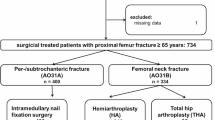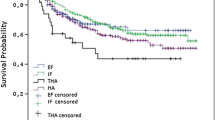Abstract
Purpose
Despite intense research and innovations in peri-operative management, a high mortality rate and frequent systemic complications in trochanteric femoral fractures persist.
The aim of the present study was to identify predictive factors for mortality and cardio-respiratory complications after different treatment methods in a ten year period at a level I trauma centre.
Methods
Retrospectively, all patients above 60 years of age with trochanteric femoral fracture between January 2000 and May 2011 were analyzed at a level I trauma centre. Demographic variables, comorbidities, and data regarding the surgical procedures, including required transfusions and post-operative complications, were evaluated, and the in-hospital mortality was recorded. The grade of osteoporosis was classified radiographically using the Singh index.
Results
The in-hospital mortality rate was 8.2% among 437 patients (male/female ratio = 110/327, mean age = 81 years) with extramedullary open (n = 144), intramedullary (n = 166), and extramedullary minimally invasive (n = 125) procedures. Significant influential factors on in-hospital mortality were identified with binary logistic regression analysis: an age of ≥90 years (P = 0.011), male sex (P = 0.003), a high American Society of Anesthesiologists (ASA) grade (3–5, P = 0.042), and a high osteoporosis grade (Singh index 3–1, P = 0.011). A total of 21.5% of the study population suffered cardio-respiratory complications post-operatively. The specific mortality was 28.7% (P < 0.001), which was influenced by a high ASA grade (3–5, P = 0.002) and a high transfusion rate (P = 0.004). Minimally invasive locked plating was associated with increased cardio-respiratory complications (P = 0.031).
Conclusions
This study identified high patient age, distinctive comorbidities, male sex, and high osteoporosis grade as significant risk factors for increased in-hospital mortality in the treatment of trochanteric femoral fractures. Furthermore, high ASA grade and a liberal transfusion regime led to an increased incidence of cardio-respiratory complications. Patient-specific characteristics, especially osteoporosis grade and pre-existing medical conditions, may assist in the identification of high-risk patients and allow a patient-specific geriatric co-management plan.

Similar content being viewed by others
References
Maggi S, Siviero P, Wetle T et al (2010) A multicenter survey on profile of care for hip fracture: predictors of mortality and disability. Osteoporos Int 21(2):223–231. https://doi.org/10.1007/s00198-009-0936-8
Chatterton BD, Moores TS, Ahmad S et al (2015) Cause of death and factors associated with early in-hospital mortality after hip fracture. Bone Joint J 97-B(2):246–251. https://doi.org/10.1302/0301-620X.97B2.35248
Mundi S, Pindiprolu B, Simunovic N et al (2014) Similar mortality rates in hip fracture patients over the past 31 years. Acta Orthop 85(1):54–59. https://doi.org/10.3109/17453674.2013.878831
Hu F, Jiang C, Shen J et al (2012) Preoperative predictors for mortality following hip fracture surgery: a systematic review and meta-analysis. Injury 43(6):676–685. https://doi.org/10.1016/j.injury.2011.05.017
Roche JJW, Wenn RT, Sahota O et al (2005) Effect of comorbidities and postoperative complications on mortality after hip fracture in elderly people: prospective observational cohort study. BMJ 331(7529):1374. https://doi.org/10.1136/bmj.38643.663843.55
Kostuj T, Smektala R, Schulze-Raestrup U et al (2013) Pertrochanteric fractures. What impact do surgical timing and implant choice have on the outcome? Unfallchirurg 116(1):53–60. https://doi.org/10.1007/s00113-011-2092-9
Johnson-Lynn S, Ngu A, Holland J et al (2016) The effect of delay to surgery on morbidity, mortality and length of stay following periprosthetic fracture around the hip. Injury 47:725–727
Brunskill SJ, Millette SL, Shokoohi A et al (2015) Red blood cell transfusion for people undergoing hip fracture surgery. Cochrane Database Syst Rev 4:CD009699. https://doi.org/10.1002/14651858.CD009699.pub2
Cheng T, Zhang G, Liu T et al (2012) A meta-analysis of percutaneous compression plate versus sliding hip screw for the management of intertrochanteric fractures of the hip. J Trauma Acute Care Surg 72(5):1435–1443. https://doi.org/10.1097/TA.0b013e318247252a
Zhang L, Shen J, Yu S et al (2014) Percutaneous compression plate versus dynamic hip screw for treatment of intertrochanteric hip fractures: a meta-analyse of five randomized controlled trials. Sci World J 2014:512512. https://doi.org/10.1155/2014/512512
Diamantopoulos AP, Hoff M, Hochberg M et al (2013) Predictors of short- and long-term mortality in males and females with hip fracture—a prospective observational cohort study. PLoS One 8(10):e78169. https://doi.org/10.1371/journal.pone.0078169
Perez JV, Warwick DJ, Case CP et al (1995) Death after proximal femoral fracture—an autopsy study. Injury 26(4):237–240
Knobe M, Siebert CH (2014) Hip fractures in the elderly: osteosynthesis versus joint replacement. Orthopade 43(4):314–324. https://doi.org/10.1007/s00132-014-2265-7
American Society of Anesthesiologists (1963) New classification of physical status. Anesthesiology 24:111
Singh M, Nagrath AR, Maini PS (1970) Changes in trabecular pattern of the upper end of the femur as an index of osteoporosis. J Bone Joint Surg Am 52:457–467
Mueller ME, Nazarian S, Koch P et al (1990) The comprehensive classification of fractures of long bones. Springer, Heidelberg, pp 120–121
Knobe M, Pape HC (2016) Focus on co-management in geriatric fracture care. Eur J Trauma Emerg Surg 42(5):533–535. https://doi.org/10.1007/s00068-016-0695-0
Coburn M, Röhl AB, Knobe M et al (2016) Anesthesiological management of elderly trauma patients. Anaesthesist 65(2):98–106. https://doi.org/10.1007/s00101-016-0136-9
Wiles MD, Moran CG, Sahota O et al (2011) Nottingham hip fracture score as a predictor of one year mortality in patients undergoing surgical repair of fractured neck of femur. Br J Anaesth 106(4):501–504. https://doi.org/10.1093/bja/aeq405
Bliemel C, Buecking B, Oberkircher L et al (2017) The impact of pre-existing conditions on functional outcome and mortality in geriatric hip fracture patients. Int Orthop. https://doi.org/10.1007/s00264-017-3591-2
Bachmann S, Finger C, Huss A et al (2010) Inpatient rehabilitation specifically designed for geriatric patients: systematic review and meta-analysis of randomised controlled trials. BMJ 340:c1718. https://doi.org/10.1136/bmj.c1718
Patel SH, Murphy KP (2006) Fractures of the proximal femur: correlates of radiological evidence of osteoporosis. Skelet Radiol 35(4):202–211. https://doi.org/10.1007/s00256-005-0065-1
Ye C, Xu M, Wang S et al (2016) Decreased bone mineral density is an independent predictor for the development of atherosclerosis: a systematic review and meta-analysis. PLoS One 11(5):e0154740. https://doi.org/10.1371/journal.pone.0154740
Minyan L, Lei G, Yu P et al (2015) Efficacy of zoledronic acid in treatment of osteoporosis in men and women—a meta-analysis. Int J Clin Exp Med 8:3855–3861
Lyles KW, Colón-Emeric CS, Magaziner JS et al (2007) Zoledronic acid in reducing clinical fracture and mortality after hip fracture. N Engl J Med 357:nihpa40967. https://doi.org/10.1056/NEJMoa074941
Bolland MJ, Grey AB, Gamble GD et al (2010) Effect of osteoporosis treatment on mortality: a meta-analysis. J Clin Endocrinol Metab 95:1174–1181
Black DM, Rosen CJ (2016) Clinical practice. Postmenopausal osteoporosis. N Engl J Med 374(3):254–262. https://doi.org/10.1056/NEJMcp1513724
Kanis JA, McCloskey EV, Johansson H et al (2013) European guidance for the diagnosis and management of osteoporosis in postmenopausal women. Osteoporos Int 24(1):23–57. https://doi.org/10.1007/s00198-012-2074-y
Kim SC, Kim M, Sanfélix-Gimeno G et al (2015) Use of osteoporosis medications after hospitalization for hip fracture: a cross-national study. Am J Med 128(5):519–26.e1. https://doi.org/10.1016/j.amjmed.2015.01.014
Balasubramanian A, Tosi LL, Lane JM et al (2014) Declining rates of osteoporosis management following fragility fractures in the U.S., 2000 through 2009. J Bone Joint Surg Am 96(7):e52. https://doi.org/10.2106/JBJS.L.01781
Ma K, Wang X, Luan F et al (2014) Proximal femoral nails antirotation, gamma nails, and dynamic hip screws for fixation of intertrochanteric fractures of femur: a meta-analysis. Orthop Traumatol Surg Res 100(8):859–866. https://doi.org/10.1016/j.otsr.2014.07.023
Knobe M, Gradl G, Maier KJ et al (2013) Rotationally stable screw-anchor versus sliding hip screw plate systems in stable trochanteric femur fractures: a biomechanical evaluation. J Orthop Trauma 27(6):e127–e136. https://doi.org/10.1097/BOT.0b013e318278112a
Knobe M, Gradl G, Buecking B et al (2015) Locked minimally invasive plating versus fourth generation nailing in the treatment of AO/OTA 31A2.2 Fractures: a biomechanical comparison of PCCP(®) and Intertan nail(®). Injury 46(8):1475–1482. https://doi.org/10.1016/j.injury.2015.05.011
Shiga T, Wajima Z, Ohe Y (2008) Is operative delay associated with increased mortality of hip fracture patients?: systematic review, meta-analysis, and meta-regression. Can J Anesth/J Can Anesth 55(3):146–154. https://doi.org/10.1007/BF03016088
Forni S, Pieralli F, Sergi A et al (2016) Mortality after hip fracture in the elderly: the role of a multidisciplinary approach and time to surgery in a retrospective observational study on 23,973 patients. Arch Gerontol Geriatr 66:13–17. https://doi.org/10.1016/j.archger.2016.04.014
Wendt K, Heim D, Josten C et al (2016) Recommendations on hip fractures. Eur J Trauma Emerg Surg 42(4):425–431. https://doi.org/10.1007/s00068-016-0684-3
Belmont PJ, Garcia EJ, Romano D et al (2014) Risk factors for complications and in-hospital mortality following hip fractures: a study using the National Trauma Data Bank. Arch Orthop Trauma Surg 134(5):597–604. https://doi.org/10.1007/s00402-014-1959-y
Chatterjee S, Wetterslev J, Sharma A et al (2013) Association of blood transfusion with increased mortality in myocardial infarction: a meta-analysis and diversity-adjusted study sequential analysis. JAMA Intern Med 173(2):132–139. https://doi.org/10.1001/2013.jamainternmed.1001
Twomley KM, Rao SV, Becker RC (2006) Proinflammatory, immunomodulating, and prothrombotic properties of anemia and red blood cell transfusions. J Thromb Thrombolysis 21(2):167–174. https://doi.org/10.1007/s11239-006-5206-4
Ma J, Xing D, Ma X et al (2012) The percutaneous compression plate versus the dynamic hip screw for treatment of intertrochanteric hip fractures: a systematic review and meta-analysis of comparative studies. Orthop Traumatol Surg Res 98(7):773–783. https://doi.org/10.1016/j.otsr.2012.07.004
Knobe M, Münker R, Schmidt-Rohlfing B et al (2008) Surgical outcome in Pertrochanteric femur fracture: the impact of osteoporosis. Comparison between DHS and percutaneous compression plate. Z Orthop Unfall 146:44–51. https://doi.org/10.1055/s-2007-989314
Buecking B, Hoffmann R, Riem S et al (2014) AltersTraumaZentrum DGU® (AltersTraumaZentrum DGU®). Unfallchirurg 117(9):842–848. https://doi.org/10.1007/s00113-014-2622-3
Acknowledgements
We would like to thank those medical and non-medical collaborators who were involved in the surgical and non-surgical treatment of our hip fracture patients.
Funding
None.
Author information
Authors and Affiliations
Corresponding author
Ethics declarations
Conflict of interest
The authors declare that they have no conflict of interest.
Ethical approval
Ethics committee of the RWTH Aachen University Hospital, ethics approval EK 210/11.
Informed consent
Each author certifies that his or her institution approved the human protocol for this investigation, that all investigations were conducted in conformity with the ethical principles of research, and that informed consent for participation in the study was obtained.
Rights and permissions
About this article
Cite this article
Carow, J., Carow, J.B., Coburn, M. et al. Mortality and cardiorespiratory complications in trochanteric femoral fractures: a ten year retrospective analysis. International Orthopaedics (SICOT) 41, 2371–2380 (2017). https://doi.org/10.1007/s00264-017-3639-3
Received:
Accepted:
Published:
Issue Date:
DOI: https://doi.org/10.1007/s00264-017-3639-3




